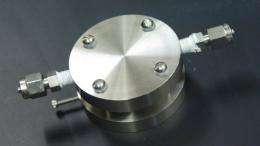February 1, 2011 weblog
Lithium-air batteries' high energy density could extend range of electric vehicles

(PhysOrg.com) -- For today's electric vehicles that run on lithium-ion batteries, one of the biggest downsides is the limited range between recharging. Over the past several years, researchers have been working on an alternative battery called a lithium-air battery. These batteries could significantly increase the range of electric vehicles due to their high energy density, which could theoretically be equal to the energy density of gasoline.
At the fall meeting of the Materials Research Society in Boston, Ming Au, a scientist from the Savannah River National Laboratory in Aiken, S.C., said that no other known battery has as high of an energy density as lithium-air batteries. Researchers estimate that these batteries could hold 5-10 times the energy of lithium-ion batteries of the same weight, and twice the energy for the same volume.
Lithium-air batteries have an anode made of lithium and an “air cathode” made of a porous material that draws in oxygen from the surrounding air. When the lithium combines with the oxygen, it forms lithium oxide and releases energy. Since the oxygen doesn’t need to be stored in the battery, the cathode is much lighter than that of a lithium-ion battery, which gives lithium-air batteries their high energy density.
At the meeting, Au said that his research group has demonstrated a coin-sized rechargeable lithium-air battery with a current density of 600 mAh/g, which is much higher than the current densities of 100 to 150 mAh/g of lithium-ion batteries.
But one of the biggest challenges facing lithium-air batteries is their limited number of charge/discharge cycles. Whereas lithium-ion batteries can be recharged more than 100,000 times, Au’s lithium-air battery can be recharged only about 50 times. Although single-use lithium-air batteries are already being used, for example to power hearing aids, electric vehicles require batteries that can be recharged thousands of times.
The biggest problem with recharging lithium-air batteries is that it’s very difficult to convert the lithium oxide back into lithium. Currently, researchers can do this only by using catalysts, and even then some of the lithium oxide cannot be converted because it builds up in the battery. Researchers also face challenges in speeding up the recharging process and in keeping water vapor out of the oxygen, since lithium reacts violently with water.
At the meeting, Au said that rechargeable lithium-air batteries would probably not be commercially available for several years, noting that lithium-ion batteries were first proposed in the 1970s but not commercialized until 1997. (Lithium-air batteries were first demonstrated in the mid-‘90s.) Au added that a “big investment from the government or some corporation” would have to be secured for developing a commercial product.
More information: via: IEEE Spectrum
© 2010 PhysOrg.com

















